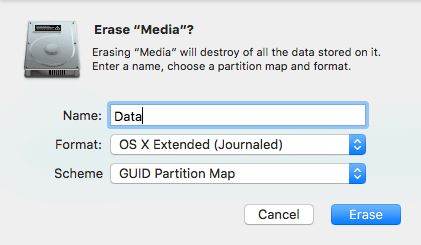How To Format An External Drive For Mac Scheme
- How To Format Hard Drive For Mac
- How To Format An External Hard Drive For Mac
- How To Format An External Drive To Fat32
To format an external storage device, connect it to one of the ports on your Mac. Turn the drive on, and make sure it appears in the Finder. If the drive is internal, it should already show up in. Format external drives to Mac OS Extended before using with Aperture Tips on preparing a new external hard drive for use with Aperture. You may wish to use an external FireWire or USB hard drive to store your Aperture Library, referenced images, or Vaults.
To get started, you'll first have to format the hard drive from NTFS to HFS+. Here's how: Plug your HD into the Mac and open Disk Utility, which can be accessed by searching for it in Spotlight. Then, select your hard drive from the left sidebar. Now go to the Erase tab. In the Volume Format list, select Mac OS Extended (Journaled).
In the left sidebar, you should see your hard drive and its partitions. Right-click the Windows partition and select Format. In the Format dialog box, under File System, select FAT32. Click OK and complete the format process. With these three options you'll be able to take advantage of either platform's offerings, be it Time Machine support or security options.
How To Format Hard Drive For Mac
For example, you might want more storage for your Mac than you do for your PC. Now, click on the top partition, name it 'Windows,' and change its format to MS-DOS. Then click the second partition, name it 'Mac,' and change its format to Mac OS Extended (Journaled).
How To Format An External Hard Drive For Mac
To format a drive on a Mac, you’ll need the built-in Disk Utility application. Press Command+Space to open the Spotlight search dialog, type “Disk Utility”, and press “Enter” to launch the app. You can also open a Finder window, select “Applications” in the sidebar, and head to Utilities > Disk Utility. Your connected drives will appear under “External” in the Disk Utility’s sidebar.
Office for mac wants me to close update so update can install. It's unmistakably Office - but thoughtfully designed to take advantage of the unique features of the Mac. You will receive regular updates automatically until the official release in the second half of 2015. Preview the new and modern Office for Mac. Office 2016 for Mac is powered by the cloud so you can access your documents anytime, anywhere, and on any device.
• MAC OS Extended(Case-Sensitive, Journaled) is used to save multiple files with the same name, for example, Pic.jpg and pic.jpg would be two different files (a very niche option). • MS-DOS FAT will be optimum for a drive that would be used with PCs and Macs alike since this format is the most compatible. • ExFAT is also a very compatible option, however, this one is fit more for flash drives. After naming your drive and picking the format and scheme, press the “ Erase” button and the formatting process will start. When the formatting process finishes, your drive should show up on your desktop, but if it doesn’t, go to Finder/Preferences and make sure that external drives are marked to be shown on your desktop. After this, you should be good to go!
How To Format An External Drive To Fat32
(Remember: This erases everything on the drive!) You can now skip directly to Step 8. If the Partition Map Scheme says Master Boot Record or Apple Partition Map, you need to continue to step 5.

• From the Volume Format menu, choose Mac OS Extended (Journaled). • Enter a name for the external hard drive in the Name field. • Click the Erase button.
This volume format accommodates Mac OS X and Mac files the best. • Give the drive one FAT32 (MS-DOS) partition, which both Mac OS X and Windows can read and write. Parallels for mac reviews. This is a good place to put files that you want both Mac and Windows to have read/write access to. The FAT volume format is showing its age, but a huge variety of OSes know how to work with it. • If you want the drive to have a volume that's more optimal for Windows than FAT, give it an NTFS partition as well.